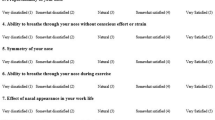Abstract
The aim of this study was to assess patients’ satisfaction based on gender and age using the Rhinoplasty Outcomes Evaluation (ROE) post-rhinoplasty from both functional and aesthetic outcomes. The study design was a prospective observational study. A total of 103 patients who underwent Rhinoplasty were prospectively investigated from January 2011 through December 2013 at King Abdulaziz University Hospital in Riyadh, Saudi Arabia. The sample included 61 males (59.2%) and 42 females (40.7%). The overall mean age was (25.2 ± 5.9) years (range 17–48 years). ROE was distributed pre- and post-surgery. The overall difference in satisfaction was significant (p < 0.0001). The mean satisfaction difference of function was increased by 21.5%, raising the satisfaction percentage from 57.1% initially to 78.5% post-surgery (mean −0.215, CI −0.269, −0.161). Satisfaction of shape post-rhinoplasty showed that the mean satisfaction increased by 31.3% (mean −0.313, CI −0.369, −0.256), which changed the satisfaction from a mean of 44.2% before surgery to 75.5% post-rhinoplasty (p = 0.000). There was no significant difference in satisfaction between males and females, nor was there a significant difference in satisfaction among different age groups (p > 0.05). There was a significant overall increase in patients’ satisfaction from functional and aesthetic outcomes post-surgery based on ROE. Our study showed that age and gender did not significantly affect satisfaction. The ROE was a useful tool to implement for assessing the quality-of-life post-rhinoplasty.
Similar content being viewed by others
References
The WHOQOL Group (1998) The World Health Organization Quality of Life Assessment (WHOQOL): development and psychometric properties. Soc Sci Med 46:1569–1585
Alsarraf R, Larrabee JWF, Anderson S, Murakami CS, Johnson JCM (2001) measuring cosmetic facial plastic surgery outcomes: a pilot study. Arch Facial Plast Surg 3(3):198
Bagheri SC, Khan HA, Jahangirnia A, Rad SS, Mortazavi H (2012) An analysis of 101 primary cosmetic rhinoplasties. J Oral Maxillofac Surg 70(4):902–909
Haack J, Papel ID (2009) Caudal septal deviation. Otolaryngol Clin N Am 42(3):427–436
Arima LM, Velasco LC, Tiago RS (2012) Influence of age on rhinoplasty outcomes evaluation: a preliminary study. Aesthetic Plast Surg 36(2):248–253
Lisandra Megumi A, Leandro Castro V, Romualdo Suzano Louzeiro T (2011) Crooked nose: outcome evaluations in rhinoplasty Nariz torto: avaliação de resultados em rinoplastia. Br J Otorhinolaryngol 4:510
Deepalakshmi T, Gururaj T, Sushant K, Devan PP, Rukma B (2015) Assessment of clinical outcomes of rhinoplasty—a clinical study. Online J Otolaryngol 5(4):118
Saleh AM, Younes A, Friedman O (2012) Cosmetics and function: quality-of-life changes after rhinoplasty surgery. Laryngoscope 122(2):254–259
Hellings PW, Nolst Trenite GJ (2007) Long-term patient satisfaction after revision rhinoplasty. Laryngoscope 117(6):985–989
Gunel C, Omurlu IK (2015) The effect of rhinoplasty on psychosocial distress level and quality of life. Eur Arch Otorhinolaryngol 8:1931
Biggs TC, Fraser LR, Ward MJ, Sunkaraneni VS, Harries PG, Salib RJ (2015) Patient reported outcome measures in septorhinoplasty surgery. Ann R Coll Surg Engl 97(1):63–65
Cingi C, Songu M, Bal C (2011) Outcomes research in rhinoplasty: body image and quality of life. Am J Rhinol Allergy. 25(4):263–267
Eloteify M, El-Shazly M, Saadeldeen W, El-Sonbaty M (2015) Subjective psychic perception versus objective nasofacial measures in assessment of rhinoplasty results: a clinical report. Eur J Plast Surg 2:109
Acknowledgements
Ms. Norjanah Dimatunday, Staff for Research Team, ENT Department, King Abdulaziz University Hospital, for editing and formatting the manuscript based on journal’s requirement.
Author information
Authors and Affiliations
Corresponding author
Ethics declarations
Ethical standards
This was approved by the Institutional Review Board (IRB) at King Saud University.
Funding
The work was not supported or funded by any drug company.
Conflict of interest
Author has no conflict of interests.
Ethical approval
This article does not contain any studies with animals performed by any of the authors.
Rights and permissions
About this article
Cite this article
AlHarethy, S., Al-Angari, S.S., Syouri, F. et al. Assessment of satisfaction based on age and gender in functional and aesthetic rhinoplasty. Eur Arch Otorhinolaryngol 274, 2809–2812 (2017). https://doi.org/10.1007/s00405-017-4566-z
Received:
Accepted:
Published:
Issue Date:
DOI: https://doi.org/10.1007/s00405-017-4566-z




